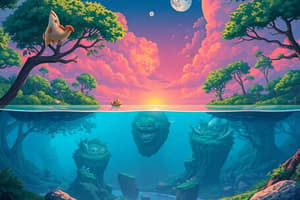Podcast
Questions and Answers
What are ecosystems and what do they consist of?
What are ecosystems and what do they consist of?
Ecosystems are the complex whole of organisms living in an area, along with their interactions.
What is a food chain?
What is a food chain?
A food chain is a representation of feeding interactions in an ecosystem, showing who dines on whom.
Give an example of a food chain in a freshwater lake ecosystem.
Give an example of a food chain in a freshwater lake ecosystem.
Aquatic plants -> Stonefly larva -> Bluegill -> Osprey
How does energy flow through an ecosystem?
How does energy flow through an ecosystem?
Explain the one-directional flow of energy in a food chain.
Explain the one-directional flow of energy in a food chain.
How is energy transferred from one trophic level to the next in a food web?
How is energy transferred from one trophic level to the next in a food web?
What are some factors that can cause energy loss in a food web?
What are some factors that can cause energy loss in a food web?
Using the example given, how much energy would be transferred from a grasshopper to a robin if the grasshopper has 100 kilojoules of energy?
Using the example given, how much energy would be transferred from a grasshopper to a robin if the grasshopper has 100 kilojoules of energy?
What happens to the remaining energy that is not transferred to the next trophic level?
What happens to the remaining energy that is not transferred to the next trophic level?
Does the rule of thumb that 10% of energy is transferred hold true for energy transfers between all trophic levels?
Does the rule of thumb that 10% of energy is transferred hold true for energy transfers between all trophic levels?
What are trophic levels and why are they important in understanding the flow of energy in a food chain?
What are trophic levels and why are they important in understanding the flow of energy in a food chain?
Describe the role of producers in an ecosystem and provide examples of producers.
Describe the role of producers in an ecosystem and provide examples of producers.
What is the difference between primary consumers and secondary consumers? Give examples of each.
What is the difference between primary consumers and secondary consumers? Give examples of each.
What are tertiary consumers and quaternary consumers? Provide examples of each.
What are tertiary consumers and quaternary consumers? Provide examples of each.
What is a food web and how does it differ from a food chain?
What is a food web and how does it differ from a food chain?
Flashcards are hidden until you start studying




